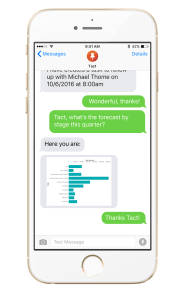Customer Relationship Management (CRM) software was born with the best of intentions — to create a record of customer interactions. The problem, salespeople will tell you, is that it becomes a chore. Tact has been designed to add an intelligent layer to CRM — and today it got $15 million to make CRM easier to use.
The Series B round was led by Upfront Ventures. Microsoft Ventures and existing investors Accel Partners and Redpoint Ventures also participated. Under the terms of today’s deal, Upfront’s Mark Suster will join the Tact board. Tact has now raised more than $30 million, according to the company.
Tact founder Chuck Ganapathi knows a thing or two about CRM software, having spent a decade working for CRM companies — first at Siebel Systems, then Salesforce.com.
Ganapathi says the idea for the company came from his own experience working in the industry and facing poor adoption rates, which he says, are hovering around 20-30 percent. “The basic concept comes from my own life in the CRM industry. Over those years of building products, the elephant in room was why do salespeople hate CRM.”
 He formed Tact in 2012 with the idea of improving that experience. The goal of Tact’s product today is not to build a better CRM, but to make your CRM tool easier to use by turning your device into a smart assistant. The idea is to build an intelligent layer on top of that CRM system.
He formed Tact in 2012 with the idea of improving that experience. The goal of Tact’s product today is not to build a better CRM, but to make your CRM tool easier to use by turning your device into a smart assistant. The idea is to build an intelligent layer on top of that CRM system.
For today, Tact is working with Salesforce, but as the Microsoft investment suggests, it could be branching out to cover other CRM tools over time.
While Ganapathi acknowledges that the industry has been doing a good job of building artificial intelligence into their applications, he says they have a different purpose in mind. The CRM tool wants to use AI to help predict outcomes and find the most likely sales. “We don’t do that. Our use case for AI is to change the human/computer interaction. We want to change the way you use technology to do your job.”
It does that in a number of ways — through touch using an app, through voice with the Amazon Echo and through bot-like interactions inside of messaging tools. For example, using the Echo, you can perform activities like looking up individuals in LinkedIn, linking to them and adding them to Salesforce — all with voice interactions. The smartphone app could prompt you to enter data right after a meeting or show you other customers on a map in the area around your current appointment. You could ask the bot to set a reminder for your next appointment or show you the current quarterly sales forecast.
The company is beginning to see some traction with customers like GE, Kelly Services and AES, and it wants to use today’s investment to continue to build on that success.
